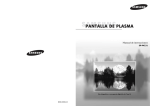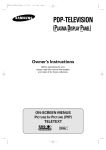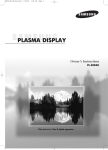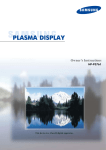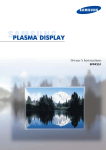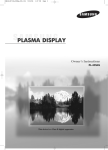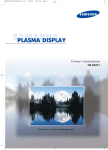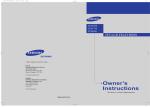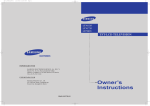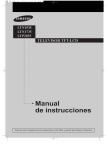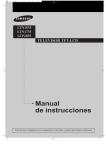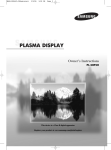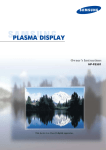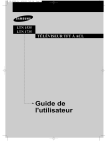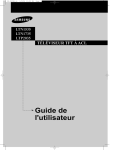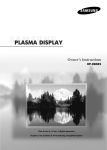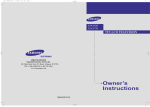Download Samsung SP-P4231 User Manual
Transcript
BN68-00631B-00_001,104Eng 2004.6.9 10:53 AM Page 3 Owner’s Instructions SP-P4231 This device is a Class B digital apparatus. BN68-00631B-00_002-013Eng 2004.6.9 10:54 AM Page 2 Important Warranty Information Regarding Television Format Viewing Wide screen format PDP Displays (16:9,the aspect ratio of the screen width to height) are primarily designed to view wide screen format full-motion video. The images displayed on them should primarily be in the wide screen 16:9 ratio format, or expanded to fill the screen if your model offers this feature and the images are constantly moving. Displaying stationary graphics and images on screen, such as the dark side-bars on nonexpanded standard format television video and programming, should be limited to no more than 5% of the total television viewing per week. Additionally,viewing other stationary images and text such as stock market reports, video game displays,station logos, web sites or computer graphics and patterns,should be limited as described above for all televisions. Displaying stationary images that exceed the above guidelines can cause uneven aging of PDP Displays that leave subtle, but permanent burned-in ghost images in the PDP picture. To avoid this, vary the programming and images, and primarily display full screen moving images, not stationary patterns or dark bars. On PDP models that offer picture sizing features, use these controls to view different formats as a full screen picture. Be careful in the selection and duration of television formats used for viewing. Uneven PDP aging as a result of format selection and use, as well as burned-in images, are not covered by your Samsung limited warranty. User Instructions Screen Image retention Do not display a still image (such as on a video game or when hooking up a PC to this PDP) on the plasma display panel for more than several minutes as it can cause screen image retention. This image retention is also known as “screen burn”. To avoid such image retention, refer to page 40 of this manual to reduce the degree of brightness and contrast of this screen when displaying a still image. Cell Defect The plasma display panel consists of fine cells. Although the panels are produced with more than 99.9 percent active cells, there may be some cells that do not produce light or remain lit. Altitude The PDP will not operate normally at altitudes above 6500 ft. Warranty Warranty does not cover any damage caused by image retention. Burn-in is not covered by the warranty. 2 BN68-00631B-00_002-013Eng 2004.6.9 10:54 AM Page 3 Table of Contents General Information Channel Control Your New Plasma Display Panel ......................6 Fine Tuning Channels ..................................64 Remote Control Buttons ..................................8 Wall Installation Instructions ..........................10 Connecting a PC and Operation How to assemble the Stand-Base ..................14 Connection a PC ........................................66 Connecting Speakers ..................................15 Adjusting the PC Screen ..............................70 Changing the Position of the Image................71 Connections Picture Quality Adjustment ..........................72 Connecting VHF and UHF Antennas ..............18 Information ................................................75 Connecting Cable TV ..................................19 Connecting a VCR ......................................21 Time Setting Connecting a Camcorder ............................22 Setting the Clock ........................................78 Connecting a DVD Player ............................23 Setting the Sleep Timer ................................79 Connecting a DTV Receiver ..........................24 Setting the Timers ........................................80 Operation Function Description Turning the PDP On and Off ........................26 Selecting a Menu Language ........................84 Plug & Play Feature......................................28 Digital Noise Reduction ..............................85 Memorizing the Channels ............................31 Selecting the Film Mode ..............................86 Viewing an External Signal Source ..............36 Setting the Melody Sound ............................87 Setting the Blue Screen ................................88 Picture Control Viewing Closed Captions ............................89 Customizing the Picture ..............................40 Using the V-Chip..........................................90 Using Automatic Picture Settings ..................41 Selecting the Color Tone ..............................42 Appendix DNIe (Digital Natural Image engine) ............43 Troubleshooting ..........................................98 Changing the Screen Size ..........................44 Care and Maintenance ................................99 Freezing the Picture ...................................46 Specifications............................................100 Viewing the Picture-in-Picture .......................47 Selecting a Signal Source (Antenna or Cable) for PIP .....52 Sound Control Customizing the Sound ................................56 Using Automatic Sound Settings ...................57 Choosing a Multi-Channel Sound (MTS)Soundtrack ......58 Using the Auto Volume ................................59 Setting the TruSurround XT ............................60 Selecting the Internal Mute............................61 3 BN68-00631B-00_002-013Eng 2004.6.9 10:54 AM Page 4 BN68-00631B-00_002-013Eng 2004.6.9 10:54 AM P L A Page 5 S M A D I S P L A Y P A N E L General Information Your New Plasma Display Panel ......................................................6 Remote Control Buttons ..................................................................8 Wall Installation Instructions ..........................................................10 How to assemble the Stand-Base ....................................................14 Connecting Speakers ....................................................................15 BN68-00631B-00_002-013Eng 2004.6.10 7:32 PM Page 6 Your New Plasma Display Panel Front Panel Power Indicator SOURCE/ENTER button Press to display all of the available video sources. (ie., TV, AV, S-Video, Component, PC, DVI). Press to confirm a selection. MENU button Displays the main on-screen menu and exit. VOL(+,-) button - Power Off - Power On - Timer On : Red : Off : Green Remote Control Signal Receiver Aim the remote control towards this spot on the PDP. Press to increase or decrease the volume. Also used to select or adjust items on the on-screen menu. CH( , ) button Press CH or CH to change Channels. Also used to move up or down in the On-screen menu. I/ Press to turn the PDP on and off. Checking Accessories Once you have unpacked your PDP, check to make sure that you have all the parts shown here. If any piece is missing or broken, call your dealer. Sold Separately Owner’s Instructions Remote Control (BN59-00376B)/ Ferrite Core 2EA AAA Batteries (4301-000103) (3301-001110) Power Cord (3909-000144) 6 Antenna Cable (BN39--00333A) Speaker Cables (BN39-00530A) S-VIDEO Cable DVI Cable PC Cable Component Cables (RCA) PC Audio Cable BN68-00631B-00_002-013Eng 2004.6.9 10:54 AM Page 7 Rear Panel Œ DVI INPUT Connect to the digital video and audio output jack of a device with DVI output. ´ MONITOR OUT (VIDEO / L-AUDIO-R) Outputs for external devices ˇ PC INPUT (RGB IN / AUDIO) Connect to the video and audio output jack on your PC. ¨ ONLY FOR SERVICE Connector for service only. ˆ S-VIDEO Video and audio inputs for external devices with an S-Video output, such as a camcorder or VCR. Ø AV (VIDEO / L-AUDIO-R) Video and audio inputs for external devices, such as a camcorder or VCR. ∏ COMPONENT Video (Y/Pb/Pr) and audio (L-AUDIO-R) inputs for Component. ” ANT IN VHF/UHF (75Ω) 75Ω Coaxial connector for Antenna/Cable Network. ’ EXT SPEAKER (8Ω) Connectors for external speakers. ˝ POWER IN Connect the supplied power cord. 7 BN68-00631B-00_002-013Eng 2004.6.9 10:54 AM Page 8 Remote Control Buttons Remote Control 8 BN68-00631B-00_002-013Eng 2004.6.9 10:54 AM Page 9 Œ POWER button S. MODE button ´ Number buttons Ò PRE-CH button ˇ +100 button Ú TV/VIDEO button ¨ MUTE button Æ CH (Channel) buttons ˆ VOL (Volume) buttons ı INFO button Turns the PDP on and off. Select Sound effect. Tunes to the previous channel. Press to select channels over 100. For example, to select channel 121, press “+100”, then press “2” and “1.” Press to mute the PDP sound. Press to display all of the available video sources (ie., Video, S-Video, Component, PC, DVI). Use it to switch channels. Use it to adjust volume. Press to display information on the PDP screen. Ø SLEEP button Press to select a preset time interval for automatic shutoff. ˜ EXIT button Press to exit the menu. ∏ MENU button ¯ Up/Down Left/Right buttons ” ENTER button ˘ P. SIZE button ’ ADD/DEL button ¿ STILL button Displays the main on-screen menu. Control the cursor in the menu. Confirms a selection. Setect Picture size. Press to add or delete channels in the TV’s memory. ˝ AUTO PROG. button The TV automatically cycles through all of the available channels and stores them in memory. Ô P.MODE button Press to pause the current screen. ¸ CAPTION button Controls the caption decoder. ˛ MTS button Press to choose stereo, mono or Separate Audio Program (SAP broadcast). Adjust the PDP picture by selecting one of the preset factory settings (or select your personal, customized picture settings.) Installing the Batteries in Your Remote Control the back cover 1 Slide to open the battery compartment of the remote control. two AAA size batter2 Install ies. Make sure to match the “+” and “-” ends of the batteries with the diagram inside the compartment. the cover back into 3 Slide place. Remote Control Operation Range. You can use your remote control within a distance of 23 feet and an angle of 30 degrees from the left and right sides of the PDP’s remote control receiver. 9 BN68-00631B-00_002-013Eng 2004.6.9 10:54 AM Page 10 Wall Installation Instructions This wall mount bracket installation guide is for the following models: SP-P4231 Installation Notes 1 2 Do not install the PDP on any location other than a vertical wall. 3 Use only recommended parts and components. To protect the performance of the PDP and prevent problems, avoid the following locations: • Do not install next to smoke and fire detectors. • Do not install in an area subjected to vibration or high voltage. • Do not install near or around any heating apparatus. Parts (Wall attachment panel is sold separately. Check with your dealer) Wall Mount Bracket ASSY-HINGE 1EA LEFT :1EA RIGHT :1EA Support Bars Screws Insulation Holder : SCREW! : 4 EA SCREW@ : 12 EA 4 EA 2EA 10 BN68-00631B-00_002-013Eng 2004.6.9 10:54 AM Page 11 How to assemble the Wall Mount Bracket 1 The wall mount comes packaged in 3 parts. These parts must be assembled together. Please tighten the captive screw in the direction of the arrow after assembling the bracket. Install the Wall Mount Bracket after the screws are securely inserted into the wall. Captive Screws ASSY-HINGE (LEFT) Wall Mount Bracket Separate ASSY-HINGE into Left and Right. ASSY-HINGE (RIGHT) 2 After installing the Wall Mount Bracket, assemble the support bars and hinges (as illustrated) using screws provided. (12 screws(@) are provided. For safety reasons, make sure all 12 screws are firmly attached.) 3 After securing the screws, be sure that every part is firmly attached (as shown in the illustration). Wall Mount Bracket ASSY-HINGE (LEFT) Support Bars Support Bars ASSY-HINGE (RIGHT) ASSYHINGE (LEFT) ASSY-HINGE (RIGHT) 11 BN68-00631B-00_002-013Eng 2004.6.9 10:54 AM Page 12 Wall Installation Instructions Fixing the PDP panel to the wall attachment panel bracket 1 Remove the screws from the back of the PDP. 2 Connect insulation holders to screws (see the illustration below). 3 • If you are uncertain about installation, hire a specialist to install the wall mount bracket. • Be sure to check that the insulation holders are completely secured on both the left and right side after hanging the PDP on the wall mount bracket. • Be careful to avoid getting your fingers caught during installation. • Make sure the wall attachment panels are tightened. Otherwise the PDP may fall. Tighten the screws of the insulation holders to the back of the PDP. 4 Put the 4 insulation holders on the PDP in the grooves of the wall mount bracket and pull down on the PDP (Œ) to secure it to the wall mount bracket (´). Tighten the screws as shown (ˇ) so that the PDP cannot be separated from wall mount bracket. ˇ PDP panel Œ ´ Wall attachment panel bracket Note Wall • A 5 inch(12.7 cm) gap is needed between the back of the Plasma TV and the wall. 12 BN68-00631B-00_002-013Eng 2004.6.9 10:54 AM Page 13 How to Adjust Mounting Angle Notice : Please secure the mounting bracket on the wall surface after setting its angle at 0°. Factory default How to Adjust Mounting Angle Please tighten the captive screw in the direction of the arrow after assembling the bracket. Hold onto the middle of the PDP to adjust the angle (not the sides of the PDP). Change Angle 1 2 3 Secure the SET to the wall mount bracket. (Please refer to the following instructions.) Set the angle by pulling the upper end of the SET attached to bracket in the direction of the arrow. The angle can be adjusted from 0° to 15° by ±2°. Connecting External Devices to the PDP 1 Be sure to remove the safety pins underneath the PDP. (Caution : If the safety pins are not removed, the angle cannot be adjusted.) Any attempt to do so may cause damage to the PDP. 2 Hold onto the bottom of the PDP and pull forward fully as directed by the arrow(as illustrated) to adjust the angle. (0°~20° by 2°). Insert the Safety Pins to the front guide holes on both sides as illustrated in figure ´. 3 Viewing the PDP after connecting the external devices. Remove the Safety Pins to adjust the angle to 0°, and then secure the Safety Pins again. (Warning : For safety, be sure to secure the PDP using the safety pins. If the safety pins are not used, the PDP may fall, causing serious injury.) Note • Contact an authorized technician when installing the wall attachment panel. • After hanging the PDP panel on the wall attachment panel, make sure that the Insulation holders are completely hung. • Be careful not to get your fingers caught during installation. • Make sure the wall attachment panel brackets are tightened. Otherwise, the PDP panel may fall down. • Please secure the mounting bracket on the wall surface after setting its angle at 0°. 13 BN68-00631B-00_014-061Eng 2004.6.9 10:56 AM Page 14 How to assemble the Stand-Base 1 Assemble two support pins with the stand base and firmly secure both sides of the support pins using 8 screws provided. 2 Assemble the PDP with the stand and firmly secure the PDP using 4 screws provided. ➤ Two or more people should carry the PDP. Never lay the PDP on the floor because of possible damage to the screen. Always store the PDP upright. 14 BN68-00631B-00_014-061Eng 2004.6.9 10:56 AM Page 15 Connecting Speakers 1 Remove the screws on the rear of the PDP. 2 Hang the two “T” shaped hangers on the square holes on the rear of the PDP. 3 Tighten the PDP and the speaker bracket using the screws removed from the PDP. ➤ When moving your PDP, do NOT hold the speaker connected to your PDP. It may damage the bracket clamping the speaker and your PDP together and result in a drop of your PDP and a risk of personal damage and injury. 15 BN68-00631B-00_014-061Eng 2004.6.9 10:56 AM Page 16 Connect the speaker audio cable to the external speaker output jack on the rear of the PDP matching the “+” and “-” ends of the cable with the diagram on the PDP. ➤ The speakers MUST have to a power handling capability of 10 watts minimum (impedance 8Ω). When you connect the speaker wire to the external speaker out connector, first bind the speaker wire round the ferrite core to secure it. Ferrite Cores The ferrite cores are used to attenuate undesired signals. When connecting cables, attach one of these ferrite cores to the cable near the connector. 16 BN68-00631B-00_014-061Eng 2004.6.9 10:56 AM P L A Page 17 S M A D I S P L A Y P A N E L Connections Connecting Connecting Connecting Connecting Connecting Connecting VHF and UHF Antennas ..............................................18 Cable TV....................................................................19 a VCR........................................................................21 a Camcorder ..............................................................22 a DVD Player..............................................................23 a DTV Receiver ..........................................................24 BN68-00631B-00_014-061Eng 2004.6.9 10:56 AM Page 18 Connecting VHF and UHF Antennas Antennas with 75-ohm Round Leads If your antenna looks like this: 1 18 it has 75-ohm round leads. Plug the antenna lead into the VHF/UHF terminal on the PDP. Use the Antenna Cable, an accessory included in the product package. BN68-00631B-00_014-061Eng 2004.6.9 10:56 AM Page 19 Connecting Cable TV You can connect different cable systems to your PDP, including cable without a cable box, and cable with a cable box that descrambles some or all channels. Cable without a Cable Box 1 Plug the incoming cable into the VHF/UHF terminal on the PDP. Use the Antenna Cable, an accessory included in the product package. Cable with a Cable Box that Descrambles All Channels. 1 Find the cable connected to the ANTENNA OUT terminal on your cable box. This terminal might be labeled "ANT OUT", "VHF OUT" or simply "OUT". 2 Connect the cable to the VHF/UHF terminal on the PDP. Use the Antenna Cable, an accessory included in the product package. 19 BN68-00631B-00_014-061Eng 2004.6.9 10:56 AM Page 20 Cable with a Cable Box that Descrambles Some (But Not All) Channels To complete this connection you will need a two-way splitter, an RF (A/B) switch, and four coaxial cables (which you can buy from your Samsung dealer or any electronics store). 1 Find and disconnect the cable that is connected to the ANTENNA IN terminal of your cable box. This terminal might be labeled "ANT IN", "VHF IN" or simply, "IN". Connect this cable to a two-way splitter. 2 Connect a coaxial cable between an OUTPUT terminal of the splitter and the IN terminal of the cable box. 3 Connect a coaxial cable between the ANTENNA OUT terminal of the cable box and the B-IN terminal of the A/B switch. 4 Connect a coaxial cable between the ANTENNA OUT terminal of the cable box and the B-IN terminal of the A/B switch. 5 Connect the last coaxial cable between the OUT terminal of the RF (A/B) switch and the VHF/UHF terminal on the PDP. After you've made this connection, set the A/B switch to the "A" position for normal viewing. Set the A/B switch to the "B" position to view scrambled channels. (When you set the A/B switch to "B", you will need to tune your Set-Top Box to the cable box's output channel, which is usually channel 3 or 4.) 20 BN68-00631B-00_014-061Eng 2004.6.9 4:48 PM Page 21 Connecting a VCR Connecting a VCR to the Video or S-Video/Audio jack PDP VCR Power Plug Audio Cable S-Video Cable Video Cable How to Connect Connect the Video/Audio cables between the VIDEO or S-VIDEO / L - AUDIO - R jacks on the PDP and VIDEO or S-VIDEO / L - AUDIO - R output jacks on the VCR. (Note: For better video, you can use an S-Video cable.) Note • Please be sure to match the color coded input terminals and cable jacks. Videotape Playback: 1. Turn on your PDP. 2. Press the TV/VIDEO button to select “VIDEO” or “S-VIDEO”. 3. Turn on your VCR, insert a videotape and press the play button. 21 BN68-00631B-00_014-061Eng 2004.6.9 4:48 PM Page 22 Connecting a Camcorder Viewing camcorder tapes Camcorder PDP Power Plug Video Cable Audio Cable How to Connect Connect a Video/Audio cable between the VIDEO or S-VIDEO / L - AUDIO - R jacks on the PDP and the VIDEO or S-VIDEO /AUDIO output jacks on the camcorder. (Note: For better video, you can use an S-VIDEO cable) Note • Please be sure to match the color coded input terminals and cable jacks. Viewing Tapes 1. Turn on your PDP. 2. Press the TV/VIDEO button to select “VIDEO” or “S-VIDEO”. 3. Turn on your camcorder and set it to Video Mode. (For details, refer to your camcorder Owner’s instructions.) 4. Set the IN/OUT switch on your camcorder to OUT. 5. Insert the tape into the camcorder and press the Play button. 22 BN68-00631B-00_014-061Eng 2004.6.9 4:48 PM Page 23 Connecting a DVD Player (480i, 480p) This PDP displays the optimum picture in 720p mode. Playing DVD PDP DVD Player Power Plug Video Cable Audio Cable How to Connect 1 Connect a Video Cable between the Y, Pb, Pr (COMPONENT) input jacks on the PDP and Y, Pb, Pr output jacks on the DVD player. 2 Connect a Audio Cable between the AUDIO L/R(COMPONENT) input jacks on the PDP and the AUDIO output jacks on the DVD player. Note • Please be sure to match the color coded input terminals and cable jacks. To Play DVD: 1. Turn on your PDP. 2. Press the TV/VIDEO button to select “COMPONENT”. 3. Turn on your DVD player, insert a DVD disc and press the Play button. • For an explanation of Component video, see your DVD owner’s instructions. 23 BN68-00631B-00_014-061Eng 2004.6.9 4:48 PM Page 24 Connecting a DTV Receiver (480p, 720p, 1080i) This PDP displays the optimum picture in 720p mode. Watching DTV PDP DTV Receiver Power Plug Video Cable Audio Cable or DVI Cable Use a DVI-D connection cable. (sold separately) How to Connect 1 2 3 Connect the cable or antenna to the antenna input jack on the DTV. Connect a Video cable between the Y, Pb, Pr (COMPONENT) or DVI jack on the PDP and the Y, Pb, Pr (COMPONENT) or DVI output jacks on the DTV receiver. Connect an Audio cable between the COMPONENT (L/R AUDIO) or DVI (L/R AUDIO) jacks on the PDP and the AUDIO output jacks on the DTV receiver. Note • Please be sure to match the color coded input terminals and cable jacks. To Watch DTV: 1. Turn on your PDP. 2. Press the TV/VIDEO button to select “COMPONENT” or “DVI”. 3. Turn on your DTV receiver. • For an explanation of Component video, see your DTV receiver owner’s instructions. 24 BN68-00631B-00_014-061Eng 2004.6.9 10:56 AM P L A Page 25 S M A D I S P L A Y P A N E L Operation Turning the PDP On and Off ..........................................................26 Plug & Play Feature ......................................................................28 Memorizing the Channels..............................................................31 Viewing an External Signal Source ................................................36 BN68-00631B-00_014-061Eng 2004.6.9 10:56 AM Page 26 Turning the PDP On and Off Turning the PDP On and Off Press the POWER button on the remote control. The PDP will be turned on and you will be ready to use its features. You can also use the POWER ( )button on the front of the PDP. Viewing the Menus and Displays Your PDP has a simple, easy-to-use menu system that appears on the PDP screen. This system makes it convenient and fast to use features on the PDP. Your PDP also lets you display the status of many of your PDP’s features. Viewing the Menus 1 With the power on, press the MENU button on the remote control. The main menu appears on the screen. The Input menu is selected. Input TV Source List Edit Name Move 2 Press the ▲ or ▼ buttons to move items in the menu. Press the œ /√/ENTER buttons to display, change, or use the selected items. Press the ENTER ( ) button to enter items in the menu. On screen menus disappear from the screen automatically after about two minutes, or you can press the MENU or EXIT button on your remote control to exit the menu. 26 : TV √ √ Enter Return BN68-00631B-00_014-061Eng 2004.6.9 10:56 AM Page 27 Displaying Status Information Press the INFO button on the remote control. The PDP will display the Picture mode, Sound mode, MTS, Caption, and Clock. Air Mono 4 V-Chip CC Picture Sound MTS Clock : : : : Custom Custom Stereo 12 : 00 am 27 BN68-00631B-00_014-061Eng 2004.6.9 10:57 AM Page 28 Plug & Play Feature When the television is initially powered ON, several basic customer settings proceed automatically and subsequently. The following settings are available. 1 If the television is in Standby mode, press the POWER button on the remote control. Plug & Play Start Plug & Play ➤ The message Start Plug & Play is displayed and then the Language menu is automatically displayed. Start Enter 2 Select the appropriate language by pressing the ▲ or ▼ button. Language English Français Español ➤ The message Antenna input check is displayed. Move 3 Press the ENTER button to confirm your choice. Exit Enter Skip Plug & Play Check antenna input. Enter 4 28 Press the ENTER button. Skip BN68-00631B-00_014-061Eng 5 2004.6.9 10:57 AM Page 29 Select the correct signal source (Air, STD, HRC and IRC) by pressing the ▲ or ▼ button, then press the ENTER button. Air/CATV Air STD HRC IRC Move Enter To start the search, press the ENTER button. 6➤ Skip Auto Program The search will end automatically. Channels are sorted and stored in an order which reflects their position in the frequency range (with lowest first and highest last). When it has finished, the Clock Set menu is displayed. Start Enter ➤ To stop the search before it has finished or return to normal Skip viewing, press the MENU button. Auto Program Air 30 Stop Enter 7 Press the ENTER button. Press the œ or √ button to move to the Hour, Minute, or am/pm. Set the Hour, Minute, or am/pm by pressing the ▲ or ▼ button. Press the ENTER button. Skip Clock Hour Minute am/pm -- -- am Enter 8 When it has finished, the message Enjoy Your Watching is displayed, and then the channels which have been stored can be viewed. Skip Enjoy your watching. 29 BN68-00631B-00_014-061Eng 2004.6.9 10:57 AM Page 30 Plug & Play Feature (continued) If you want to reset this feature... 1 Press the MENU button. Press the ▲ or ▼ button to select “Setup”, then press the ENTER button. Setup TV Language Time Caption Digital NR V-Chip Miscellaneous PC Move 2 3 Press the ▲ or ▼ button to select “Miscellaneous”, then press the ENTER button. Press the ▲ or ▼ button to select “Plug & Play”. Press the ENTER button. : English : On √ √ √ √ √ √ √ Enter Return Miscellaneous TV Melody Plug & Play Blue Screen : On : On √ √ √ Move Enter Return Plug & Play Start Plug & Play Start Enter 4 For further details on how to set, refer to the previous page. Note • Plug and Play can only be accessed in the TV mode. 30 Return BN68-00631B-00_014-061Eng 2004.6.9 10:57 AM Page 31 Memorizing the Channels Your PDP can memorize and store all of the available channels for both “off-air” (antenna) and cable channels. After the available channels are memorized, use the CH and CH buttons to scan through the channels. This eliminates the need to change channels by entering the channel digits. There are three steps for memorizing channels: selecting a broadcast source, memorizing the channels (automatic) and adding and deleting channels (manual). Selecting the Video Signal-source Before your television can begin memorizing the available channels, you must specify the type of signal source that is connected to the PDP (i.e., an antenna or a cable system). 1 Press the MENU button. Press the ▲ or ▼ button to select “Channel”, then press the ENTER button. Channel TV Air/CATV Auto Program Add/Delete Fine Tune Scan Move 2 Press the ENTER button to select “Air/CATV”. Move 3 Enter Return : Air Air STD HRC IRC Enter Return Channel TV Air/CATV Auto Program Add/Delete Fine Tune Scan Move 4 √ √ √ √ √ Channel TV Air/CATV Auto Program Add/Delete Fine Tune Scan Press the ▲ or ▼ button to select “Air”, “STD”, “HRC” or “IRC”, then press the ENTER button. • If you are connected to an antenna, leave “Air” displayed. If you connected cable, press the ▲ or ▼ button to the display the type of cable system: “STD”, “HRC” or “IRC”. (If you are not sure which type of cable system you have, contact your cable company). : Air : Air Air STD HRC IRC Enter Return Press the MENU button to exit. Note • STD, HRC and IRC identify various types of cable TV systems. Contact your local cable company to identify the type of cable system that exists in your particular area. At this point the signal source has been selected. Proceed to “Storing Channels in Memory” (Next page). 31 BN68-00631B-00_014-061Eng 2004.6.9 10:57 AM Page 32 Storing Channels in Memory (Automatic Method) 1 First, select the correct signal source (Air, STD, HRC and IRC). See steps on previous page. Press the MENU button. Press the ▲ or ▼ button to select “Channel”, then press the ENTER button. Channel TV Air/CATV Auto Program Add/Delete Fine Tune Scan Move 2 Press the ▲ or ▼ button to select “Auto Program”, then press the ENTER button. ➤ Quick way to access the Automatic Channel Setting: Just press the “AUTO PROG.” button on the remote control. 3 Air/CATV Auto Program Add/Delete Fine Tune Scan Enter Return : Air √ √ √ √ √ Enter Return Auto Program Start Enter 4 √ √ √ √ √ Channel TV Move Press the ENTER button. The PDP will begin memorizing all of the available channels. After all the available channels are stored, the Auto program menu reappears. Press the ENTER button to stop. : Air Return Press the MENU button to exit. Note • The PDP automatically cycles through all of the available channels and stores them in memory. This takes about one to two minutes. 32 BN68-00631B-00_014-061Eng 2004.6.9 10:57 AM Page 33 Adding and Erasing Channels (Manual Method) First, press the CH or CH button or the number buttons to select the channel you want to add or delete. 1 Press the MENU button. Press the ▲ or ▼ button to select “Channel”, then press the ENTER button. Channel TV Air/CATV Auto Program Add/Delete Fine Tune Scan ➤ Quick way to access the Adding and Erasing Channels : Just press the “ADD/DEL” button on the remote control. Move 2 Press the ▲ or ▼ button to select “Add/Delete”, then press the ENTER button. Repeatedly pressing ENTER button will alternate between “Add” and “Delete”. Press the CH or CH button to change channels you want to add or delete. √ √ √ √ √ Enter Return Channel TV Air/CATV Auto Program Add/Delete Fine Tune Scan Move 3 : Air : Air √ √ √ √ √ Enter Return Add/Delete Press the MENU button to exit. Air 4 Deleted Add Change Enter Return Note • You can view any channel (including an erased channel) by using the number buttons on the remote control. 33 BN68-00631B-00_014-061Eng 2004.6.9 10:57 AM Page 34 To View Memorized Channel 1 Press the MENU button. Press the ▲ or ▼ button to select “Channel”, then press the ENTER button. Channel TV Air/CATV Auto Program Add/Delete Fine Tune Scan Move 2 Press the ▲ or ▼ button to select “Scan”, then press the ENTER button. Only the memorized channels are chosen. : Air √ √ √ √ √ Enter Return Scan Air 4 Return 3 34 Press the MENU button to stop. Press the MENU button to exit. BN68-00631B-00_014-061Eng 2004.6.9 4:41 PM Page 35 Changing Channels Using the Channel Buttons Press the CH or CH button to change channels. When you press the CH or CH button, the PDP changes channels in sequence. You will see all the channels that the PDP has memorized. (The PDP must have memorized at least three channels.) You will not see channels that were either erased or not memorized. Directly Accessing Channels Press the number buttons to go directly to a channel. For example, to select channel 27, press “2” then “7”. The TV will change channels when you press the second number. When you use the number buttons, you can directly select channels that were either erased or not memorized. To select a channel over 100, press the +100 button. (For channel “112”, press the +100 button, then “2”, then “2”. To change to single-digit channels (0~9) faster, press “0” before the single digit. (For channel “4” press “0”, then “4”. Using the PRE-CH button to select the previous channel Press the PRE-CH button. The TV will switch to the last channel viewed. To quickly switch between two channels that are far apart, tune to one channel, then use the number button to select the second channel. Then, use the PRE-CH button to quickly alternate between them. Adjusting the Volume Using the Volume Buttons Press the VOL + or VOL – button to increase or decrease the volume. Using Mute Using the MUTE Buttons At any time, you can temporarily cut off the sound using the MUTE button. 1 Press the MUTE button and the sound cuts off. The word “Mute” will appear in the lower-left corner of the screen. 2 To turn mute off, press the MUTE button again, or simply press the VOL + or VOL – button. Mute 35 BN68-00631B-00_014-061Eng 2004.6.9 10:57 AM Page 36 Viewing an External Signal Source Use the remote control to switch between viewing signals from connected equipment, such as VCRs, DVD, Set-Top box and the TV source (broadcast or cable). Setting the Signal Source 1 Press the MENU button. Press the ENTER button to select “Input”. Input TV Source List Edit Name : TV √ √ Enter Return ➤ Quick way to access viewing an external signal source : Just press the “TV/VIEDO” button on the remote control. Move 2 3 Press the ENTER button to select “Source List”. Press the ▲ or ▼ button to select signal source, then press the ENTER button. Note Source List TV TV AV S-Video Component PC DVI ---------------- Move Enter Source List TV TV AV S-Video Component PC DVI ---------------- Move Enter • When you connect equipment to the PDP, you can choose between the following sets of jacks: AV, S-Video, Component, Monitor OUT, PC or DVI on the PDP’s rear panel. 36 Return Return BN68-00631B-00_014-061Eng 2004.6.9 10:57 AM Page 37 Assigning Names to External input mode 1 Press the MENU button. Press the ENTER button to select “Input”. Input TV Source List Edit Name : TV √ √ Edit Name Move 2 Press the ▲ or ▼ button to select “Edit Name”, then press the ENTER button. Enter Return Edit Name TV AV S-Video Component PC DVI : : : : : ---------------- √ √ √ √ √ Edit Name Move 3 Press the ENTER button. Press the ▲ or ▼ button to select external device, then press the ENTER button. • You can select the VCR, DVD, Cable STB, HD STB, Satellite STB, AV Receiver, DVD Receiver, Game, Camcorder, DVD Combo, DHR or PC. • Set other signal sources (AV, S-Video, Component, PC or DVI) using the same method as listed above. Return Edit Name TV AV S-Video Component PC DVI : : : : : ---- ---- - - - VCR ---DVD ---Cable STB ---- √ √ √ √ √ HD STB Satellite STB † Move 4 Enter Enter Return Press the MENU button to exit. Note • DHR : DVD HDD Recorder. 37 BN68-00631B-00_014-061Eng 2004.6.9 10:57 AM Page 38 BN68-00631B-00_014-061Eng 2004.6.9 10:57 AM P L A Page 39 S M A D I S P L A Y P A N E L Picture Control Customizing the Picture ................................................................40 Using Automatic Picture Settings ....................................................41 Selecting the Color Tone................................................................42 DNIe (Digital Natural Image engine) ............................................43 Changing the Screen Size ............................................................44 Freezing the Picture ......................................................................46 Viewing the Picture-in-Picture..........................................................47 Selecting a Signal Source (Antenna or Cable) for PIP ........................52 BN68-00631B-00_014-061Eng 2004.6.9 4:49 PM Page 40 Customizing the Picture You can use the on-screen menus to change the Contrast, Brightness, Sharpness, Color, and Tint settings of your PDP. 1 Press the MENU button. Press the ▲ or ▼ button to select “Picture”, then press the ENTER button. Picture TV Mode Custom Color Tone Color Control Film Mode Size DNIe PIP Move 2 Press the ▲ or ▼ button to select “Custom”, then press the ENTER button. You will also see the items “Contrast”, “Brightness”, “Sharpness”, “Color” and “Tint”. 3 Contrast Press the MENU button to exit. Notes • In the PC/DVI mode, you can’t adjust the Color and Tint. • If you make any changes to these settings, the picture standard is automatically switched to the custom. 40 : Off : 16:9 : On Enter Contrast Brightness Sharpness Color Tint G 50 ➤ By pressing ▲ or ▼ you can change between the items. 4 : Normal √ √ √ √ √ √ √ √ Return Custom TV Move Press the ▲ or ▼ button to select the item you wish to change, then press the ENTER button. Press the œ or √ button to change the value of the item. : Custom 60 35 50 55 R 50 Enter Return 74 BN68-00631B-00_014-061Eng 2004.6.9 10:57 AM Page 41 Using Automatic Picture Settings Your PDP has automatic picture settings that allow you to adjust the video display easily. 1 Press the MENU button. Press the ▲ or ▼ button to select “Picture”, then press the ENTER button. Picture TV Mode Custom Color Tone Color Control Film Mode Size DNIe PIP ➤ Quick way to access the picture setting: Just press the “P.MODE” button on the remote control. Move 2 Press the ENTER button to select “Mode”. Move 3 : Normal : Off : 16:9 : On Enter Return Dynamic : Custom Standard : Normal Movie Custom : Off : 16:9 : On Enter Return Picture TV Mode Custom Color Tone Color Control Film Mode Size DNIe PIP Move 4 √ √ √ √ √ √ √ √ Picture TV Mode Custom Color Tone Color Control Film Mode Size DNIe PIP Press the ▲ or ▼ button to select “Dynamic”, “Standard”, “Movie”, “Custom” picture setting, then press the ENTER button. • You can select “Entertain”, “Internet”, “Text”, or “Custom” in PC/DVI mode. : Custom Dynamic : Custom Standard : Normal Movie : Off Custom : 16:9 : On Enter Return Press the MENU button to exit. • Choose Dynamic for viewing the TV during the day or when there is bright light in the room. • Choose Standard for the standard factory settings. • Choose Movie when viewing the movie. • Choose Custom if you want to adjust the settings according to personal preference. (see “Customizing the Picture”, page 40). 41 BN68-00631B-00_014-061Eng 2004.6.9 10:57 AM Page 42 Selecting the Color Tone 1 Press the MENU button. Press the ▲ or ▼ button to select “Picture”, then press the ENTER button. Picture TV Mode Custom Color Tone Color Control Film Mode Size DNIe PIP Move 2 Press the ▲ or ▼ button to select “Color Tone”, then press the ENTER button. 3 Mode Custom Color Tone Color Control Film Mode Size DNIe PIP 4 42 : Off : 16:9 : On Enter Return : Custom : Normal Cool2 Cool1 : Off Normal : 16:9 : OnWarm1 Warm2 Enter Return Picture TV Mode Custom Color Tone Color Control Film Mode Size DNIe PIP Move Press the MENU button to exit. : Normal √ √ √ √ √ √ √ √ Picture TV Move Press the ▲ or ▼ button to select “Cool2”, “Cool1”, “Normal”, “Warm1” or “Warm2”. • You can select “Custom”, “Cool”, Normal” or “Warm” in PC mode. • You can select “Cool”, “Normal” or “Warm” in DVI mode. : Custom : Custom : Normal Cool2 Cool1 : Off Normal : 16:9 : OnWarm1 Warm2 Enter Return BN68-00631B-00_014-061Eng 2004.6.9 4:49 PM Page 43 DNIe (Digital Natural Image engine) Samsung’s New Technology brings you more detailed images with contrast, white enhancement and 3D noise reduction. 1 Press the MENU button. Press the ▲ or ▼ button to select “Picture”, then press the ENTER button. Picture TV Mode Custom Color Tone Color Control Film Mode Size DNIe PIP Move 2 Press the ▲ or ▼ button to select “DNIe”, then press the ENTER button. 3 • On : Switches on the DNIe mode. • Off : Switches off the DNIe mode. • Demo : The screen before applying DNIe appears on the right and the screen after applying DNIe appears on the left. 4 : Normal : Off : 16:9 : On Enter √ √ √ √ √ √ √ √ Return Picture TV Mode Custom Color Tone Color Control Film Mode Size DNIe PIP Move Press the ▲ or ▼ button to select “On”, “Off” or “Demo”, then press the ENTER button. : Custom : Custom : Normal : OffOn : 16:9 : OnOff Demo Enter Return Picture TV Mode Custom Color Tone Color Control Film Mode Size DNIe PIP Move : Custom : Normal : OffOn : 16:9 : OnOff Demo Enter Return Press the MENU button to exit. 43 BN68-00631B-00_014-061Eng 2004.6.9 10:57 AM Page 44 Changing the Screen Size Screen size selection depends on the type of video input ( DVD, PC etc.). 1 Press the MENU button. Press the ▲ or ▼ button to select “Picture”, then press the ENTER button. Picture TV Mode Custom Color Tone Color Control Film Mode Size DNIe PIP ➤ Quick way to access the Screen Size menu : Just press the “P. SIZE” button on the remote control. Move 2 Press the ▲ or ▼ button to select “Size”, then press the ENTER button. 3 Mode Custom Color Tone Color Control Film Mode Size DNIe PIP : Normal : Off : 16:9 : On Enter Return : Custom √ √ √ √ √ √ √ √ : Normal : Off : 16:9 : On Enter Return Size TV 16 : 9 Panorama Zoom 4:3 Move 4 √ √ √ √ √ √ √ √ Picture TV Move Press the ▲ or ▼ button to select the screen size you want, then press the ENTER button. : Custom Enter Return Press the MENU button to exit. Note • If you watch a still image or the 4:3 (Normal) mode for a long time (over 2 hours), an image may be burned onto the screen. View the monitor in 16:9(Wide) or Panorama mode as much as possible. 44 BN68-00631B-00_014-061Eng 2004.6.9 10:57 AM Page 45 16:9(W ide) 16:9 Aspect Ratio that fits DVD and Wide Screen applications. 16:9 Panorama Fits a 16:9 picture onto a 4:3 screen and displays it without clipping the image. Panorama Zoom Magnifies the 16:9 wide picture (in a vertical direction) to fit the screen size. Select by pressing the œ or √ button. Use the ▲ or ▼ button to move the picture up and down. After selecting , use the ▲ or ▼ button to magnify or reduce the picture size in a vertical direction. Zoom 4 : 3(Nor mal) Standard TV and VCR screen size having a 4:3 Aspect Ratio. 4:3 Notes • In TV, VIDEO, S-VIDEO and Component (480i) modes, all screen modes can be selected. (Wide ➞ Panorama ➞ Zoom ➞ Normal). • In PC/DVI mode, only 16:9 & 4:3 modes can be selected. • In Component (480p, 720p. 1080i) modes, Panorama mode can’t be selected. • In Component (480p, 720p. 1080i) modes, you can move the picture on screen by pressing the ▲ or ▼ button. (All screen modes) • Changing the screen size to Normal, or Zoom during PIP mode will cause the PIP window to disappear. 45 BN68-00631B-00_014-061Eng 2004.6.9 10:57 AM Page 46 Freezing the Picture Still Press the STILL button on the remote control to freeze a moving picture. Press again to cancel. 46 BN68-00631B-00_014-061Eng 2004.6.9 10:57 AM Page 47 Viewing the Picture-in-Picture Selecting the PIP Screen 1 2 Picture TV Press the MENU button. Press the ▲ or ▼ button to select “Picture”, then press the ENTER button. Mode Custom Color Tone Color Control Film Mode Size DNIe PIP Press the ▲ or ▼ button to select “PIP”, then press the ENTER button. Move PIP Source Swap Size Position Air/CATV Channel 3 Move PIP Source Swap Size Position Air/CATV Channel • Check if the V-Chip Lock (refer to page 91) is ON if the PIP On/Off will not function. PIP does not function when the V-Chip Lock is set to On. Change the setting to Off and try it again. 4 : Custom : Off : 16:9 : On Enter Return : Off : TV : : : Air : 4 √ √ √ √ √ √ √ Enter Return PIP TV Note √ √ √ √ √ √ √ √ PIP TV Press the ENTER button, then press the ▲ or ▼ button to select “On”. The PIP image will appear in the corner of the screen. • Pressing the ▲ or ▼ button will alternate between “On” and “Off”. : Custom Move : Off Off : TV On : : : Air : 4 Enter Return Press the MENU button to exit. O : PIP and Swap Operate X : PIP doesn’t Operate PIP Settings Main screen TV AV S-VHS Comp480i Comp480p~ DVI PC TV X X X X O O O AV X X X X O O O S-VHS Comp480i Comp480p~ DVI PC X X X X O O O PIP screen X X X X X X X O O O X X X X O O O X X X X O O O X X X X 47 BN68-00631B-00_014-061Eng 2004.6.10 7:33 PM Page 48 Selecting an External Signal You can use PIP to view a signal from an external source, such as a VCR. 1 Press the MENU button. Press the ▲ or ▼ button to select “Picture”, then press the ENTER button. Picture TV Mode Custom Color Tone Color Control Film Mode Size DNIe PIP Move 2 Press the ▲ or ▼ button to select “PIP”, then press the ENTER button. 3 PIP Source Swap Size Position Air/CATV Channel 4 The signal from these inputs will not appear if you have not connected any equipment to the PDP's respective input jacks. PIP Source Swap Size Position Air/CATV Channel : Off : 16:9 : On Enter Return : On : TV : : : Air : 22 √ √ √ √ √ √ √ Enter Return : Off TV : TV AV S-Video : : Component : Air PC : 22 DVI Enter Return PIP TV PIP Source Swap Size Position Air/CATV Channel Move 5 : Normal PIP TV Move Press the ▲ or ▼ button to cycle through all of the available signal sources: “TV”, “AV”, “S-Video”, “Component”, “PC” and “DVI”. √ √ √ √ √ √ √ √ PIP TV Move Press the ▲ or ▼ button to select “Source”, then press the ENTER button. : Custom : Off TV : TV AV S-Video : : Component : Air PC : 4 DVI Enter Return Press the MENU button to exit. Notes • The PIP function operates in Wide screen(16 : 9) (16 : 9 and Panorama). • Using Multi-Screen in the Normal(4 : 3) or Zoom screen will change the size of the main screen to Wide screen. 48 BN68-00631B-00_014-061Eng 2004.6.9 10:57 AM Page 49 Swapping the Contents of the PIP Image and Main Image 1 Press the MENU button. Press the ▲ or ▼ button to select “Picture”, then press the ENTER button. Picture TV Mode Custom Color Tone Color Control Film Mode Size DNIe PIP Move 2 Press the ▲ or ▼ button to select “PIP”, then press the ENTER button. 3 PIP Source Swap Size Position Air/CATV Channel : Off : 16:9 : On Enter Return : On : TV : : : Air : 4 √ √ √ √ √ √ √ Enter Return PIP TV PIP Source Swap Size Position Air/CATV Channel Move 4 : Normal √ √ √ √ √ √ √ √ PIP TV Move Press the ▲ or ▼ button to select “Swap”, then press the ENTER button. • The image in the PIP window will appear on the main screen, and vice versa. : Custom : On : TV : : : Air : 4 √ √ √ √ √ √ √ Enter Return Press the MENU button to exit. 49 BN68-00631B-00_014-061Eng 2004.6.9 10:57 AM Page 50 Changing the Size of the PIP Window 1 Press the MENU button. Press the ▲ or ▼ button to select “Picture”, then press the ENTER button. Picture TV Mode Custom Color Tone Color Control Film Mode Size DNIe PIP ➤ Quick way to access PIP size: Just press the “P.SIZE” button on the remote control. Move 2 Press the ▲ or ▼ button to select “PIP”, then press the ENTER button. 3 PIP Source Swap Size Position Air/CATV Channel 4 PIP Source Swap Size Position Air/CATV Channel 5 50 Enter Return : On : TV : : : Air : 4 √ √ √ √ √ √ √ Enter Return : On : TV : : : Air : 4 Enter Return PIP TV PIP Source Swap Size Position Air/CATV Channel Move Press the MENU button to exit. : Off : 16:9 : On PIP TV Move Press the ▲ or ▼ button to select option you want, then press the ENTER button. : Normal √ √ √ √ √ √ √ √ PIP TV Move Press the ▲ or ▼ button to select “Size”, then press the ENTER button. : Custom : On : TV : : : Air : 4 Enter Return BN68-00631B-00_014-061Eng 2004.6.9 10:57 AM Page 51 Changing the Location of the PIP Image 1 Press the MENU button. Press the ▲ or ▼ button to select “Picture”, then press the ENTER button. Picture TV Mode Custom Color Tone Color Control Film Mode Size DNIe PIP Move 2 Press the ▲ or ▼ button to select “PIP”, then press the ENTER button. 3 PIP Source Swap Size Position Air/CATV Channel 4 PIP Source Swap Size Position Air/CATV Channel Enter Return : On : TV : : : Air : 4 √ √ √ √ √ √ √ Enter Return : On : TV : : : Air : 4 Enter Return PIP TV PIP Source Swap Size Position Air/CATV Channel Move 5 : Off : 16:9 : On PIP TV Move Press the ▲ or ▼ button to select PIP position you want, then press the ENTER button. : Normal √ √ √ √ √ √ √ √ PIP TV Move Press the ▲ or ▼ button to select “Position”, then press the ENTER button. : Custom : On : TV : : : Air : 4 Enter Return Press the MENU button to exit. Note • The Double1( ) or Double2( ) mode can not be selected in position. 51 BN68-00631B-00_014-061Eng 2004.6.9 10:57 AM Page 52 Selecting a Signal Source (Antenna or Cable) for PIP If the PIP source is TV while PIP is ON, you can select the broadcasting source of PIP picture separately from the main picture. 1 Press the MENU button. Press the ▲ or ▼ button to select “Picture”, then press the ENTER button. Picture TV Mode Custom Color Tone Color Control Film Mode Size DNIe PIP Move 2 Press the ▲ or ▼ button to select “PIP”, then press the ENTER button. 3 PIP Source Swap Size Position Air/CATV Channel 4 PIP Source Swap Size Position Air/CATV Channel 5 52 Enter Return : On : TV : : : Air : 4 √ √ √ √ √ √ √ Enter Return : On : TV : Air : STD : Air : 4 HRC IRC Enter Return PIP TV PIP Source Swap Size Position Air/CATV Channel Move Press the MENU button to exit the menu. : Off : 16:9 : On PIP TV Move If an antenna is connected, the setting is “Air”. If a Cable TV system is providing the signal, press the ▲ or ▼ button until the appropriate type of cable system is selected (“STD”, “HRC” or “IRC”). : Normal √ √ √ √ √ √ √ √ PIP TV Move Press the ▲ or ▼ button to select “Air/CATV”, then press the ENTER button. : Custom : On : TV : Air : STD : Air : 4 HRC IRC Enter Return BN68-00631B-00_014-061Eng 2004.6.9 10:57 AM Page 53 Changing the PIP Channel 1 Press the MENU button. Press the ▲ or ▼ button to select “Picture”, then press the ENTER button. Picture TV Mode Custom Color Tone Color Control Film Mode Size DNIe PIP Move 2 Press the ▲ or ▼ button to select “PIP”, then press the ENTER button. 3 PIP Source Swap Size Position Air/CATV Channel 4 PIP Source Swap Size Position Air/CATV Channel Enter Return : On : TV : : : Air : 4 √ √ √ √ √ √ √ Enter Return : On : TV : : : Air ▲ 4 : 4 ▲ Enter Return PIP TV PIP Source Swap Size Position Air/CATV Channel Move 5 : Off : 16:9 : On PIP TV Move Press the ▲ or ▼ button to change the channel that appears in the PIP window. : Normal √ √ √ √ √ √ √ √ PIP TV Move Press the ▲ or ▼ button to select “Channel”, then press the ENTER button. : Custom : On : TV : : : Air ▲ : 4 11 ▲ Enter Return Press the MENU button to exit. 53 BN68-00631B-00_014-061Eng 2004.6.9 10:57 AM Page 54 BN68-00631B-00_014-061Eng 2004.6.9 10:57 AM P L A Page 55 S M A D I S P L A Y P A N E L Sound Control Customizing the Sound ................................................................56 Using Automatic Sound Settings ....................................................57 Choosing a Multi-Channel Sound (MTS)Soundtrack ..........................58 Using the Auto Volume ..................................................................59 Setting the TruSurround XT ............................................................60 Selecting the Internal Mute ............................................................61 BN68-00631B-00_014-061Eng 2004.6.9 10:57 AM Page 56 Customizing the Sound 1 Press the MENU button. Press the ▲ or ▼ button to select “Sound”, then press the ENTER button. Sound TV Mode Custom MTS Auto Volume SRS TSXT Internal Mute Move 2 Press the ▲ or ▼ button to select “Custom”, then press the ENTER button. : Custom : : : : √ √ √ √ √ √ Stereo Off Stereo Off Enter Return Custom TV 0 R L 100 300 1K Adjust 3 Select the option (volume, balance, equalizer) to be adjusted by pressing the œ or √ button. Press the ▲ or ▼ button to reach the required setting. 4 Press the MENU button to exit. ➤ If you make any changes to the equalizer settings, the sound Mode is automatically switched to the custom mode. 56 Move 3K 10K Return BN68-00631B-00_014-061Eng 2004.6.9 10:57 AM Page 57 Using Automatic Sound Settings 1 Press the MENU button. Press the ▲ or ▼ button to select “Sound”, then press the ENTER button. Sound TV Mode Custom MTS Auto Volume SRS TSXT Internal Mute Move 2 Press the ENTER button to select “Mode”. Move 3 4 Press the MENU button to exit. : : : : √ √ √ √ √ √ Stereo Off Stereo Off Enter Return Sound TV Mode Custom MTS Auto Volume SRS TSXT Internal Mute Press the ▲ or ▼ button to select “Standard”, “Music”, “Movie”, “Speech” or “Custom” sound setting, then press the ENTER button. : Custom Standard : Custom Music : Stereo Movie : Off Speech : Stereo : OffCustom Enter Return Sound TV Mode Custom MTS Auto Volume SRS TSXT Internal Mute Move Standard : Custom Music : Stereo Movie : Off Speech : Stereo : OffCustom Enter Return • Choose Standard for the standard factory settings. • Choose Music when watching music videos or concerts. • Choose Movie when watching movie. • Choose Speech when watching a show that is mostly dialogue (i.e., news). • Choose Custom to recall your personalized settings. (see “Customizing the Sound”, page 56). 57 BN68-00631B-00_014-061Eng 2004.6.9 10:57 AM Page 58 Choosing a Multi-Channel Sound (MTS) Soundtrack Depending on the particular program being broadcast, you can listen to stereo, mono, or a Separate Audio Program. (SAP audio is usually a foreign-language translation. Sometimes SAP has unrelated information like news or weather.) 1 Press the MENU button. Press the ▲ or ▼ button to select “Sound”, then press the ENTER button. Sound TV Mode Custom MTS Auto Volume SRS TSXT Internal Mute ➤ Quick way to access the MTS menu: Just press the “MTS” button on the remote control. Move 2 Press the ▲ or ▼ button to select “MTS”, then press the ENTER button. 3 Mode Custom MTS Auto Volume SRS TSXT Internal Mute Stereo Off Stereo Off Enter Return : Custom : : : : Mono Stereo Off Stereo Stereo SAP Off Enter Return Sound TV Mode Custom MTS Auto Volume SRS TSXT Internal Mute Move : Custom : : : : Mono Stereo Off Stereo Stereo SAP Off Enter Return 4 Press the MENU button to exit. • Choose Stereo for channels that are broadcasting in stereo. • Choose Mono for channels that are broadcasting in mono, or if you are having difficulty receiving a stereo signal. • Choose SAP to listen to the Separate Audio Program, which is usually a foreign-language translation. Note • The MTS function operates in TV mode only. 58 : : : : √ √ √ √ √ √ Sound TV Move Press the ▲ or ▼ button to select “Mono”, “Stereo” or “SAP”, then press the ENTER button. : Custom BN68-00631B-00_014-061Eng 2004.6.9 10:57 AM Page 59 Using the Auto Volume Each broadcasting station has its own signal conditions, which can make it necessary to adjust the volume every time the channel is changed. “Auto volume” lets you automatically adjust the volume of the desired channel by lowering the sound output when the modulation signal is high or by raising the sound output when the modulation signal is low. 1 Press the MENU button. Press the ▲ or ▼ button to select “Sound”, then press the ENTER button. Sound TV Mode Custom MTS Auto Volume SRS TSXT Internal Mute Move 2 Press the ▲ or ▼ button to select “Auto Volume”, then press the ENTER button. 3 Mode Custom MTS Auto Volume SRS TSXT Internal Mute Stereo Off Stereo Off Enter Return : Custom : : : : Stereo Off Off Stereo On Off Enter Return Sound TV Mode Custom MTS Auto Volume SRS TSXT Internal Mute Move 4 : : : : √ √ √ √ √ √ Sound TV Move Press the ▲ or ▼ button to select “On”, then press the ENTER button. • Pressing the ▲ or ▼ button will alternate between “On” and “Off”. : Custom : Custom : : : : Stereo Off Off Stereo On Off Enter Return Press the MENU button to exit. 59 BN68-00631B-00_014-061Eng 2004.6.9 10:57 AM Page 60 Setting the TruSurround XT TruSurround XT is a patented SRS technology that solves the problem of playing 5.1 multichannel content over two speakers. Trusurround delivers a compelling, virtual surround sound experience through any two-speaker playback system. It is fully compatible with all multichannel formats. 1 Press the MENU button. Press the ▲ or ▼ button to select “Sound”, then press the ENTER button. Sound TV Mode Custom MTS Auto Volume SRS TSXT Internal Mute Move 2 Press the ▲ or ▼ button to select “SRS TSXT”, then press the ENTER button. 3 Mode Custom MTS Auto Volume SRS TSXT Internal Mute 4➤ 60 TruSurround XT, SRS and ( ) Symbol are trademarks of SRS Labs, Inc. TruSurround XT technology is incorporated under license from SRS Labs, Inc. Stereo Off Stereo Off Enter Return : Custom : : : : Stereo Off Stereo Off OffMono 3D Stereo Enter Return Sound TV Mode Custom MTS Auto Volume SRS TSXT Internal Mute Move Press the MENU button to exit. : : : : √ √ √ √ √ √ Sound TV Move Press the ▲ or ▼ button to change the setting (Off, 3D Mono or Stereo), then press the ENTER button. : Custom : Custom : : : : Stereo Off Stereo Off Off 3D Mono Stereo Enter Return BN68-00631B-00_014-061Eng 2004.6.9 10:57 AM Page 61 Selecting the Internal Mute The internal speakers can be muted in order to hear sound from external speakers you've connected. 1 Press the MENU button. Press the ▲ or ▼ button to select “Sound”, then press the ENTER button. Sound TV Mode Custom MTS Auto Volume SRS TSXT Internal Mute Move 2 Press the ▲ or ▼ button to select “Internal Mute”, then press the ENTER button. 3 • Pressing the ▲ or ▼ button will alternate between “On” and “Off”. Mode Custom MTS Auto Volume SRS TSXT Internal Mute Stereo Off Stereo Off Enter Return : Custom : : : : Stereo Off Stereo Off Off On Enter Return Sound TV Mode Custom MTS Auto Volume SRS TSXT Internal Mute Move 4 : : : : √ √ √ √ √ √ Sound TV Move Press the ▲ or ▼ button to select “On”, then press the ENTER button. : Custom : Custom : : : : Stereo Off Stereo Off Off On Enter Return Press the MENU button to exit. 61 BN68-00631B-00_062-075Eng 2004.6.9 11:0 AM Page 62 BN68-00631B-00_062-075Eng 2004.6.9 11:0 AM P L Page 63 A S M A D I S P L A Y P A N E L Channel Control Fine Tuning Channels....................................................................64 BN68-00631B-00_062-075Eng 2004.6.9 11:0 AM Page 64 Fine Tuning Channels Use fine tuning to manually adjust a particular channel for optimal reception. 1 Press the MENU button. Press the ▲ or ▼ button to select “Channel”, then press the ENTER button. Channel TV Air/CATV Auto Program Add/Delete Fine Tune Scan Move 2 Press the ▲ or ▼ button to select “Fine Tune”, then press the ENTER button. : Air √ √ √ √ √ Enter Return Fine Tune Air 4 0 Reset Move 3 Return Adjust Press the œ or √ button to adjust the fine tuning. Store Fine Tune Air 4 10 Reset Move 4 To store the fine tuning setting in the TV’s memory, press the ENTER button. (A star icon(*) will appear.) To reset the fine tuning to “0”, press the ▼ button to select “Reset”, then press the ENTER button. Return Adjust Fine Tune Air 4* 10 Reset Move 5 64 Press the MENU button to exit. Store Return Adjust Store BN68-00631B-00_062-075Eng 2004.6.9 11:0 AM P L Page 65 A S M A D I S P L A Y P A N E L Connecting a PC and Operation Connecting a PC..........................................................................66 Adjusting the PC Screen................................................................70 Changing the Position of the Image................................................71 Picture Quality Adjustment ............................................................72 Information ..................................................................................75 BN68-00631B-00_062-075Eng 2004.6.9 11:0 AM Page 66 Connecting a PC Connection to a Macintosh computer may require an adapter. PDP Power Plug DVI Cable or Use a DVI-D connection cable. (sold separately) Audio Cable PC Cable Audio Cable DVI jack (The actual configuration on your PC may be different, depending on the model.) PC PC Connecting a PC (15p D-SUB) to the PDP 1 Connect a PC cable between the PC Output jack on the PC and the RGB input jack on the PDP. 2 Connect a Audio cable between the Audio jack on the PC and the Audio input jacks (PC INPUT) on the PDP. Connecting a PC (DVI) to the PDP 1 Connect a DVI cable between the PC DVI jack on the PC and the DVI-D input jack on the PDP. 2 Connect a Audio cable between the Audio jack on the PC and the Audio L/R input (DVI INPUT) jacks on the PDP. To watch the PC screen: 66 1. Turn on your PDP. 2. Press the TV/VIDEO button on the remote control or SOURCE button on the front panel to select “PC”. 3. Turn on your PC and check for PC system requirements. (Refer to pages 68 and 69 for PC system requirements.) 4. Adjust the PC screen. (Refer to pages 70 and 72.) BN68-00631B-00_062-075Eng 2004.6.9 11:0 AM Page 67 Pin Configuration D-Sub Cable DVI-D Cable (Digital-Only Connector) • 15Pin Signal Cable (based on protruded pin) Setting up Your PDP (Plug and Play) Our adoption of the new VESA Plug and Play solution eliminates complicated and time consuming setup. It allows you to install your monitor in a Plug and Play compatible system, without the usual setup hassles and confusion. Your PC system can easily identify and configure itself for use with your display. This monitor automatically tells the PC system its Extended Display Identification data (EDID) using Display Data Channel (DDC) protocols. 67 BN68-00631B-00_062-075Eng 2004.6.9 11:0 AM Page 68 How to Set up Your PC Software (Windows only) The Windows display-settings for a typical computer are shown below. However, the actual screens on your PC will probably be different, depending upon your particular version of Windows and your particular video card. But even if your actual screens look different, the same, basic set-up information will apply in almost all cases. (If not, contact your computer manufacturer or Samsung Dealer.) On the windows screen, select in the following sequence : Start ➝ Settings ➝ Control Panel. When the control panel screen appears, click on “Display” and a display dialog-box will appear. Select the “Settings” tab in the display dialogbox. The two key variables that apply to the PDP-PC interface are “resolution” and “colors”. The correct settings for these two variables are: • Size (sometimes called “resolution”) :640 x 480 pixels. • Color: “32-bit” color Shown at left is a typical screen for “Display” dialog box. If a vertical-frequency option exists on your display settings dialog box, the correct value is “60” or “60 Hz”. Otherwise, just click “OK” and exit the dialog box. Continued... 68 BN68-00631B-00_062-075Eng 2004.6.9 11:0 AM Page 69 Notes Both screen position and size will vary, depending on the type of PC monitor and its resolution. The table below shows all of the display modes that are supported: Video Signal Resolution (Dot X Line) 640 X 350 640 X 400 640 X 480 IBM PC / AT Compatible 800 X 600 848 X 480 1024 X 768 Vertical Frequency(Hz) Horizontal Frequency(KHz) Vertical Polarity Horizontal Polarity 70.086 85.080 85.080 59.940 72.809 75.000 85.061 56.250 60.317 72.188 75.000 85.061 60.000 72.000 75.000 60.004 70.069 75.029 84.997 31.469 37.861 37.861 31.469 37.861 37.500 43.269 35.156 37.897 48.077 46.875 53.674 29.838 36.072 37.650 48.363 56.476 60.023 63.677 N N P N N N N N/P P P P P P P N N N N N N/P P P P P nVidia chipset N N P P N N P P (N: Negative / P: Positive) • The interlace mode is not supported. • The PDP operates abnormally if a non-standard video format is selected. • This sheet conforms to IBM/VESA regulations and is prepared on the basis of Analog Input. • The DVI Mode is supported same as above table. Notes • When this PDP is used as a PC display, 32-bit color is supported. • Depending on the manufacturer, your PC display screen might appear different. (and depending on your particular version of Windows.) Check your PC instruction book for information about connecting your PC to a PDP. • If a vertical and horizontal frequency-select mode exists, select 60Hz (vertical) and 31.5kHZ (horizontal). • In some cases, abnormal signals (such as stripes) might appear on the screen when the PC power is turned off (or if the PC is disconnected). If so, press the TV/VIDEO button on the remote control or SOURCE button on the front panel to enter the VIDEO mode. Also, make sure that the PC is connected. • Connect only a PC monitor to the monitor output port while viewing the PC screen. (Otherwise, random signals might appear). 69 BN68-00631B-00_062-075Eng 2004.6.9 11:0 AM Page 70 Adjusting the PC Screen Adjusting the R.G.B Preset: • Press the TV/VIDEO button to select “PC”. 1 Press the MENU button. Press the ▲ or ▼ button to select “Picture”, then press the ENTER button. Picture TV Mode Custom Color Tone Color Control Film Mode Size DNIe PIP Move 2 Press the ▲ or ▼ button to select “Color Control”, then press the ENTER button. The “Color Control” is available only when the “Color Tone” is set to Custom and a PC is connected. 70 3 4 Press the MENU button to exit. : Custom : Off : 16:9 : On Enter R G B R √ √ √ √ √ √ √ √ Return Color Control TV 50 50 50 Move Press the ▲ or ▼ button to select the item you want to change, then press the ENTER button. Press the œ or √ button to change the value of the item, using the on-screen gauge as your guide. : Custom Enter Return 50 BN68-00631B-00_062-075Eng 2004.6.9 11:0 AM Page 71 Changing the Position of the Image After connecting the PDP to your PC, adjust the position of the screen if it is not well-aligned. Preset: • Press the TV/VIDEO button to select “PC.” 1 Press the MENU button. Press the ▲ or ▼ button to select “Setup”, then press the ENTER button. Setup TV Language Time Caption Digital NR V-Chip Miscellaneous PC : English Move 2 Press the ▲ or ▼ button to select “PC”, then press the ENTER button. 3 4 √ √ √ √ Enter Return Position TV Move Return Position TV Move 5 Return Image Lock Position Information Auto Adjustment Move Adjust the position of screen by pressing the ▲ / ▼/ œ / √ button. Enter PC TV Move Press the ▲ or ▼ button to select “Position”, then press the ENTER button. : On √ √ √ √ √ √ √ Move Return Press the MENU button to exit. 71 BN68-00631B-00_062-075Eng 2004.6.9 11:0 AM Page 72 Picture Quality Adjustment Picture Automatic Adjustment Preset: • Press the TV/VIDEO button to select “PC”. 1 Press the MENU button. Press the ▲ or ▼ button to select “Setup”, then press the ENTER button. Setup TV Language Time Caption Digital NR V-Chip Miscellaneous PC Move 2 Press the ▲ or ▼ button to select “PC”, then press the ENTER button. 3 4 72 : On √ √ √ √ √ √ √ Enter Return PC TV Image Lock Position Information Auto Adjustment Move Press the ▲ or ▼ button to select “Auto Adjustment”, then press the ENTER button. The message “Auto Adjustment in progress” appears on the screen and the picture adjustments are automatically activated. : English TV √ √ √ √ Enter Return Auto Adjustment Auto Adjustment in progress. Press the MENU button to exit. Air 11 BN68-00631B-00_062-075Eng 2004.6.9 11:0 AM Page 73 Coarse Adjustment Preset: • Press the TV/VIDEO button to select “PC”. 1 Press the MENU button. Press the ▲ or ▼ button to select “Setup”, then press the ENTER button. Setup TV Language Time Caption Digital NR V-Chip Miscellaneous PC : English Move 2 Press the ▲ or ▼ button to select “PC”, then press the ENTER button. 3 5 Return Image Lock Position Information Auto Adjustment √ √ √ √ Enter Return Image Lock TV Coarse Fine Move 4 Enter PC TV Move Press the ▲ or ▼ button to select “Image Lock”, then press the ENTER button. : On √ √ √ √ √ √ √ 50 4 Enter Return Press the ENTER button to select “Coarse”. Coarse 50 Remove picture noise (vertical stripes) on the screen by pressing the œ or √ button. (If Coarse is not set properly, vertical stripes will appear on the screen.) Press the MENU button to exit. 73 BN68-00631B-00_062-075Eng 2004.6.9 11:0 AM Page 74 Fine Tuning (Fine) Preset: • Press the TV/VIDEO button to select “PC”. 1 Press the MENU button. Press the ▲ or ▼ button to select “Setup”, then press the ENTER button. Setup TV Language Time Caption Digital NR V-Chip Miscellaneous PC : English Move 2 Press the ▲ or ▼ button to select “PC”, then press the ENTER button. 3 74 4 5 Press the MENU button to exit. Return Image Lock Position Information Auto Adjustment √ √ √ √ Enter Coarse Fine Fine Return Image Lock TV Move Press the ▲ or ▼ button to select “Fine”, then press the ENTER button. Remove picture noise on the screen by pressing the œ or √ button. (If Fine is not set properly, noise will appear on the screen.) Enter PC TV Move Press the ▲ or ▼ button to select “Image Lock”, then press the ENTER button. : On √ √ √ √ √ √ √ 50 4 Enter Return 4 BN68-00631B-00_062-075Eng 2004.6.9 11:0 AM Page 75 Information Preset: • Press the TV/VIDEO button to select “PC”. 1 Press the MENU button. Press the ▲ or ▼ button to select “Setup”, then press the ENTER button. Setup TV Language Time Caption Digital NR V-Chip Miscellaneous PC Move 2 Press the ▲ or ▼ button to select “PC”, then press the ENTER button. 3 : On √ √ √ √ √ √ √ Enter Return PC TV Image Lock Position Information Auto Adjustment Move Press the ▲ or ▼ button to select “Information”, then press the ENTER button. The vertical, horizontal frequencies and resolution appear. : English √ √ √ √ Enter Return Information TV Resolution H Frequency V Frequency : 1280 * 720 : 38.0KHz : 60.5 Hz Return 4 Press the MENU button to exit. 75 BN68-00631B-00_076-103Eng 2004.6.9 11:1 AM Page 76 BN68-00631B-00_076-103Eng 2004.6.9 11:1 AM P L Page 77 A S M A D I S P L A Y P A N E Time Setting Setting the Clock .......................................................................78 Setting the Sleep Timer...............................................................79 Setting the Timers ......................................................................80 L BN68-00631B-00_076-103Eng 2004.6.9 11:1 AM Page 78 Setting the Clock 1 Press the MENU button. Press the ▲ or ▼ button to select “Setup”, then press the ENTER button. Setup TV Language Time Caption Digital NR V-Chip Miscellaneous PC Move 2 Press the ▲ or ▼ button to select “Time”, then press the ENTER button. 3 Clock Sleep Timer On Timer Off Timer 12 Adjust 4 12 Adjust Press the √ button to select “am/pm.”, then press the ▲ or ▼ button to select the proper time of day (am or pm). Press the MENU button. Hour Adjust 6 78 -- : -- am Off Off Off Enter √ √ √ √ Return Minute am/pm 00 am Move Return Minute am/pm 00 am Move Return Clock TV 12 Press the MENU button to exit. Return Clock TV Hour 5 Enter Clock TV Hour Press the √ button to select “Minute.”, then press the ▲ or ▼ button to select correct minute. : On √ √ √ √ √ √ √ Time TV Move Press the ENTER button to select “Clock”. Press the ▲ or ▼ button to select correct hour. : English Minute am/pm 00 Move am Return BN68-00631B-00_076-103Eng 2004.6.9 11:1 AM Page 79 Setting the Sleep Timer You can set your PDP to automatically turn off after a preset interval. 1 Press the MENU button. Press the ▲ or ▼ button to select “Setup”, then press the ENTER button. Setup TV Language Time Caption Digital NR V-Chip Miscellaneous PC ➤ Quick way to access the sleep timer setting: Just press the “SLEEP” button on the remote control. Move 2 Press the ▲ or ▼ button to select “Time”, then press the ENTER button. 3 Clock Sleep Timer On Timer Off Timer 4 5 √ √ √ √ Return Sleep Timer TV Minute Activation -- Off Move Return Sleep Timer TV Minute Activation 30 On Move Return Sleep Timer TV Minute Activation -- Off Adjust 6 Return Enter Adjust Press the √ button to select “Activation”, then press the ▲ or ▼ button to select “On” or “Off”. Enter -- : -- am Off Off Off Adjust Press the ▲ or ▼ button to select the time interval for the PDP to stay on. The interval ranges from 30 to 180 minutes. : On √ √ √ √ √ √ √ Time TV Move Press the ▲ or ▼ button to select “Sleep Timer”, then press the ENTER button. : English Move Return Press the MENU button to exit. 79 BN68-00631B-00_076-103Eng 2004.6.9 11:1 AM Page 80 Setting the Timers This PDP can be set to turn on or off automatically at specific times that you choose. Before using the timers, you must set the PDP’s clock, as described previously. 1 Press the MENU button. Press the ▲ or ▼ button to select “Setup”, then press the ENTER button. Setup TV Language Time Caption Digital NR V-Chip Miscellaneous PC Move 2 Press the ▲ or ▼ button to select “Time”, then press the ENTER button. 3 Clock Sleep Timer On Timer Off Timer Hour Channel 4 Enter √ √ √ √ Return Minute am/pm 00 am Volume Activation Adjust Move Off Return On Timer TV Hour Minute am/pm 00 am Volume Activation Air 3 10 Adjust Move Off Return On Timer TV Hour 12 Channel 80 -- : -- am Off Off Off 10 Channel 5 Return Air 3 12 Press the √ button to select “am/pm”, then press the ▲ or ▼ button to select the proper time of day (am or pm). Enter On Timer TV 12 Press the √ button to select “Minute.”, then press the ▲ or ▼ button to select correct minute. : On √ √ √ √ √ √ √ Time TV Move Press the ▲ or ▼ button to select “On Timer”. Press the ENTER button to select “Hour”, then press the ▲ or ▼ button to select correct hour. : English Minute am/pm 00 am Volume Activation Air 3 10 Adjust Move Off Return BN68-00631B-00_076-103Eng 6 2004.6.9 11:1 AM Page 81 Press the √ button to select “Channel”, then press the ▲ or ▼ button to select the channel you want when PDP turns on. On Timer TV Hour 12 Channel 7 Press the √ button to select “Volume”, then press the ▲ or ▼ button to select the volume level you want when PDP turns on. am Volume Activation Adjust Move Off Return On Timer TV Hour Minute am/pm 00 am ▲ Volume Activation ▲ Air 3 10 Adjust Move Off Return On Timer TV Hour 12 Channel 9 00 10 Channel 8 am/pm Air 3 12 Press the √ button to select “Activation”, then press the ▲ or ▼ button to select “On” or “Off”. Minute Minute am/pm 00 am ▲▲ ▲ Volume Activation ▲ Air 3 10 Adjust Move Off Return If you want to set Off Time, press the MENU button. Press the ▲ or ▼ button to select “Off Timer”. Set the “Off Timer” just as you set “On Timer”. 10 Press the MENU button to exit. 81 BN68-00631B-00_076-103Eng 2004.6.9 11:1 AM Page 82 BN68-00631B-00_076-103Eng 2004.6.9 11:1 AM P L Page 83 A S M A D I S P L A Y P A N E Function Description Selecting a Menu Language .....................................................84 Digital Noise Reduction ...........................................................85 Selecting the Film Mode ...........................................................86 Setting the Melody Sound ........................................................87 Setting the Blue Screen.............................................................88 Viewing Closed Captions .........................................................89 Using the V-Chip .....................................................................90 L BN68-00631B-00_076-103Eng 2004.6.9 11:1 AM Page 84 Selecting a Menu Language 1 Press the MENU button. Press the ▲ or ▼ button to select “Setup”, then press the ENTER button. Setup TV Language Time Caption Digital NR V-Chip Miscellaneous PC Move 2 Press the ENTER button to select “Language”. Move 3 4 84 Enter Return : English English Français Español : On Enter Return Configuration TV Langue : Français English Heure Français Sous-titres Español Réduct. bruit num. : Marche puce V Divers PC Dépl Press the MENU button to exit. : On √ √ √ √ √ √ √ Setup TV Language Time Caption Digital NR V-Chip Miscellaneous PC Press the ▲ or ▼ button to select the appropriate language: “English”, “Français” or “Español”. : English Entrée Retour BN68-00631B-00_076-103Eng 2004.6.9 11:2 AM Page 85 Digital Noise Reduction If the broadcast signal received by your TV is weak, you can activate the Digital Noise Reduction feature to help reduce any static and ghosting that may appear on the screen. 1 Press the MENU button. Press the ▲ or ▼ button to select “Setup”, then press the ENTER button. Setup TV Language Time Caption Digital NR V-Chip Miscellaneous PC Move 2 Press the ▲ or ▼ button to select “Digital NR”, then press the ENTER button. 3 Language Time Caption Digital NR V-Chip Miscellaneous PC Enter Return : English : On Off On Enter Return Setup TV Language Time Caption Digital NR V-Chip Miscellaneous PC Move 4 : On √ √ √ √ √ √ √ Setup TV Move Press the ▲ or ▼ button to select “On” or “Off”, then press the ENTER button. : English : English : On Off On Enter Return Press the MENU button to exit. 85 BN68-00631B-00_076-103Eng 2004.6.9 11:2 AM Page 86 Selecting the Film Mode On: Automatically senses and processes film signals from all sources and adjusts the picture for optimum quality. Off: Switches off the Film mode. 1 Press the MENU button. Press the ▲ or ▼ button to select “Picture”, then press the ENTER button. Picture TV Mode Custom Color Tone Color Control Film Mode Size DNIe PIP Move 2 Press the ▲ or ▼ button to select “Film Mode”, then press the ENTER button. 3 Mode Custom Color Tone Color Control Film Mode Size DNIe PIP Mode Custom Color Tone Color Control Film Mode Size DNIe PIP Move 4 Note • Film mode is supported in TV, Video, S-Video and Component 480i. 86 : Off : 16:9 : On Enter Return : Custom : Normal : Off Off : 16:9 On : On Enter Return Picture TV Press the MENU button to exit. : Normal √ √ √ √ √ √ √ √ Picture TV Move Press the ▲ or ▼ button to select “On” or “Off”, then press the ENTER button. : Custom : Custom : Normal : Off Off : 16:9 On : On Enter Return BN68-00631B-00_076-103Eng 2004.6.9 11:2 AM Page 87 Setting the Melody Sound You can hear clear melody sound when the television is powered on or off. 1 Press the MENU button. Press the ▲ or ▼ button to select “Setup”, then press the ENTER button. Setup TV Language Time Caption Digital NR V-Chip Miscellaneous PC Move 2 3 Press the ▲ or ▼ button to select “Miscellaneous”, then press the ENTER button. Press the ▲ or ▼ button to select “Melody”, press the ENTER button. 4 Enter Return Melody Plug & Play Blue Screen : On √ √ √ Move Enter Return : On Miscellaneous TV Melody Plug & Play Blue Screen : On Off On : On Enter Return Miscellaneous TV Melody Plug & Play Blue Screen Move 5 : On √ √ √ √ √ √ √ Miscellaneous TV Move Press the ▲ or ▼ button to change the setting. (On or Off). : English : On Off On : On Enter Return Press the MENU button to exit. 87 BN68-00631B-00_076-103Eng 2004.6.9 11:2 AM Page 88 Setting the Blue Screen If no signal is being received or the signal is very weak, a blue screen automatically replaces the noisy picture background. If you wish to continue viewing the poor picture, you must set the “Blue Screen“ mode to “Off“. 1 Press the MENU button. Press the ▲ or ▼ button to select “Setup”, then press the ENTER button. Setup TV Language Time Caption Digital NR V-Chip Miscellaneous PC Move 2 3 Press the ▲ or ▼ button to select “Miscellaneous”, then press the ENTER button. Press the ▲ or ▼ button to select “Blue Screen”, Press the ENTER button. 4 ➤ Blue Screen is displayed when there is no signal from an external 88 Return : On √ √ √ Move Enter Return : On Miscellaneous TV Melody Plug & Play Blue Screen : On : On Off On Enter Return Miscellaneous TV Melody Plug & Play Blue Screen Move Press the MENU button to exit. Enter Melody Plug & Play Blue Screen device in the External Mode, regardless of the Blue Screen Setting. 5 : On √ √ √ √ √ √ √ Miscellaneous TV Move Press the ▲ or ▼ button to select “On” or “Off”, then press the ENTER button. : English : On : On Off On Enter Return BN68-00631B-00_076-103Eng 2004.6.9 11:2 AM Page 89 Viewing Closed Captions Your TV decodes and displays the closed captions that are broadcast with certain TV shows. These captions are usually subtitles for the hearing impaired or foreign language translations. All VCRs record the closed caption signal from television programs, so home-recorded video tapes also provide closed captions. Most prerecorded commercial video tapes provide closed captions as well. Check for the closed caption symbol in your television schedule and on the tape’s packaging: . Note: The Caption feature does not work with DVD or DTV signals. 1 Press the MENU button. Press the ▲ or ▼ button to select “Setup”, then press the ENTER button. Press the ▲ or ▼ button to select “Caption”, then press the ENTER button. Setup TV Language Time Caption Digital NR V-Chip Miscellaneous PC Move 2 Press the ENTER button to select “Caption”. Press the ▲ or ▼ button to turn closed caption on/off, then press the ENTER button. 3 Caption Mode Channels Field 4 5 Press the MENU button to exit. Enter Return : : : : On Off Caption On 1 1 Enter Return Caption TV Caption Mode Channels Field Move Depending on the particular broadcast, it might be necessary to make changes to “Channels” and “Field”: Press the ▲ / ▼/ œ / √ button to make the changes. (Follow the same procedure as in steps 3 above.) : On √ √ √ √ √ √ √ Caption TV Move Press the ▲ or ▼ button to select “Mode”, then press the ENTER button. Press the ▲ or ▼ button to select “Text” or “Caption”, then press the ENTER button. : English : : : : On Caption Caption 1 Text 1 Enter Return Caption TV Caption Mode Channels Field Move : : : : On Caption 1 1 1 2 Enter Return Note • Different channels and fields display different information: Field 2 carries additional information that supplements the information in Field 1. (For example, Channel 1 may have subtitles in English, while Channel 2 has subtitles in Spanish.) 89 BN68-00631B-00_076-103Eng 2004.6.9 11:2 AM Page 90 Using the V-Chip The V-Chip feature automatically locks out programs that are deemed inappropriate for children. The user must enter a PIN (personal ID number) before any of the V-Chip restrictions are set up or changed. Note: When the V-chip feature is activated, the PIP and auto channel program features do not function. Setting Up Your Personal ID Number (PIN) 1 Press the MENU button. Press the ▲ or ▼ button to select “Setup”, then press the ENTER button. Setup TV Language Time Caption Digital NR V-Chip Miscellaneous PC : English Move 2 Press the ▲ or ▼ button to select “V-Chip”, then press the ENTER button. The message “Enter PIN” will appear. Enter your 4digit PIN number. : On √ √ √ √ √ √ √ Enter Return V-Chip TV Enter PIN * Note: The default PIN number of a new TV set is “0-0-0-0”. * * Enter PIN 3 The “V-Chip” screen will appear. Press the ▲ or ▼ button to select “Change PIN”, then press the ENTER button. TV 4 Enter New PIN TV Return Change PIN Confirm New PIN Enter PIN 5 Return Change PIN Enter PIN The Change pin screen will appear. Choose any 4digits for your PIN and enter them. As soon as the 4 digits are entered, the “Confirm New PIN” screen appears. Re-enter the same 4 digits. When the Confirm screen disappears, your PIN has been memorized. * Return Press the MENU button to exit. Note • If you forget the PIN, press the remote-control buttons in the following sequence, which resets the pin to 0-0-0-0 : Power Off. ➔ Mute ➔ 8 ➔ 2 ➔ 4 ➔ Power On. 90 BN68-00631B-00_076-103Eng 2004.6.9 11:2 AM Page 91 How to Enable/Disable the V-Chip 1 Press the MENU button. Press the ▲ or ▼ button to select “Setup”, then press the ENTER button. Setup TV Language Time Caption Digital NR V-Chip Miscellaneous PC Move 2 Press the ▲ or ▼ button to select “V-Chip”, then press the ENTER button. The message “Enter PIN” will appear. Enter your 4-digit PIN number. : English : On √ √ √ √ √ √ √ Enter Return V-Chip TV Enter PIN * * * Enter PIN 3 The “V-Chip” screen will appear. To enable the V-Chip feature, press the ENTER button so that the “V-Chip Lock” field is “On”. (Pressing the ▲ or ▼ button will alternate between “On” and “Off”.) Press the MENU button. Return V-Chip TV V-Chip Lock : Off Off TV Parental Guidelines On MPAA Rating Change Pin Move 4 * Enter Return Press the MENU button to exit. 91 BN68-00631B-00_076-103Eng 2004.6.9 11:2 AM Page 92 How to Set up Restrictions using the “TV Parental guidelines” First, set up a personal identification number (PIN), and enable the V-Chip. (See previous section.) Parental restrictions can be set up using either of two methods: The TV guidelines or the MPAA rating. 1 Press the MENU button. Press the ▲ or ▼ button to select “Setup”, then press the ENTER button. Setup TV Language Time Caption Digital NR V-Chip Miscellaneous PC Move 2 Press the ▲ or ▼ button to select “V-Chip”, then press the ENTER button. The message “Enter PIN” will appear. Enter your 4digit PIN number. : English : On √ √ √ √ √ √ √ Enter Return V-Chip TV Enter PIN * * Enter PIN 3 The “V-Chip” screen will appear. Press the ▲ or ▼ button to select “TV Parental Guidelines”, then press the ENTER button. TV 4 92 TV-Y TV-Y7 Young children Children 7 and over TV-G TV-PG TV-14 TV-MA General audience Parental guidance Viewers 14 and over Mature audience TV * Return TV Parental Guidelines Move The “TV Parental Guidelines” screen will appear. Press the ▲ or ▼ button to select one of the six ages based categories: * Enter Return TV Parental Guidelines Move Enter Return BN68-00631B-00_076-103Eng 5 2004.6.9 11:2 AM Page 93 At this point, one of the TV-Ratings is selected. Press the ENTER button. Depending on your existing setup, a symbol will be selected. (Blank = Unblocked, = Blocked) While “ ” is selected, press the ENTER button to block or unblock the category. To select a different TV-Rating, press the ▲ or ▼ button and then repeat the process. TV TV Parental Guidelines Move Enter Return Note 1: The TV-Y, TV-Y7, TV-G, TV-PG, TV-14 and TV-MA have additional options. See the next step to change any of the following sub-ratings: FV: Fantasy violence D: Sexually Suggestive Dialog L: Adult Language S: Sexual situation V: Violence Note 2: The V-Chip will automatically block certain categories that are “more restrictive”. For example, if you block “TV-Y” category, then TV-Y7 will automatically be blocked. Similarly, if you block the TV-G category, then all the categories in the “young adult” group will be blocked (TV-Y, TV-Y7, TV-G, TV-PG, TV-14 and TV-MA). The sub-ratings (D, L, S, V) work together similarly. (See next section.) 6 How to set the FV, D, L, S and V sub-ratings. First, select one of these TV-Ratings: TV-Y, TV-Y7 TV-G, TV-PG, TV-14 or TV-MA (See Step 4, on previous page), and press √ button. A symbol “ ” will be displayed for each sub-rating. While “ ” is selected, press the ENTER button to go to a sub rating. Press ENTER to block the sub rating. To select a different TV-Rating, press the ▲ or ▼ button and then repeat the process. Note: The V-chip will automatically block certain categories that are “More restrictive” . For example, if you block “L” sub-rating in TV-PG, then the “L” sub-ratings in TV-14 and TV-MA will automatically be blocked. 7 Press the MENU button to clear all the screens. (Or proceed to the next section, and set up additional restrictions based on the MPAA codes). Note • These categories consist of two separate groups: TV-Y and TV-Y7 (young children through age 7), and TV-G through TV-MA (everybody else). The restrictions for these two groups work independently: If a household includes very young children as well as young adults, the TV guidelines must be set up separately for each age group. (See next step.) 93 BN68-00631B-00_076-103Eng 2004.6.9 11:2 AM Page 94 How to Set up Restrictions using the MPAA Ratings: G, PG, PG-13, R, NC-17, X, NR The MPAA rating system uses the Motion Picture Association of America (MPAA) system, and its main application is for movies. When the V-Chip lock is on, the TV will automatically block any programs that are coded with objectionable ratings (either MPAA or TV-Ratings). 1 Press the MENU button. Press the ▲ or ▼ button to select “Setup”, then press the ENTER button. Setup TV Language Time Caption Digital NR V-Chip Miscellaneous PC Move 2 Press the ▲ or ▼ button to select “V-Chip”, then press the ENTER button. The message “Enter Pin” will appear. Enter your 4-digit PIN number. : English : On √ √ √ √ √ √ √ Enter Return V-Chip TV Enter PIN * * * Enter PIN 3 The “V-Chip” screen will appear. Press the ▲ or ▼ button to select “MPAA Rating”, then press the ENTER button. 4 G General audience (no restrictions). PG Parental guidance suggested. PG-13 PG-13 (Parents strongly cautioned). R R (Restricted. Children under 17 should be accompanied by an adult). Return MPAA Rating TV Move The “MPAA Rating” screen will appear. Repeatedly press the ▲ or ▼ button to select a particular MPAA category. Pressing the ▲ or ▼ button will cycle through the MPAA categories: * Enter Return MPAA Rating TV Move Enter Return NC-17 No children under age 17. X X (Adults only). NR Not rated. While a particular category is selected, press the ENTER button to activate it. A selected symbol “ ” will be displayed. Press the ENTER button to block or unblock the category. Note: The V-Chip will automatically block any category that is “more restrictive”. For example, if you block the “PG-13” category, then “R”, “NC-17” and “X” will automatically be blocked also. 94 BN68-00631B-00_076-103Eng 2004.6.9 11:2 AM Page 95 How to Reset the TV after the V-Chip Blocks a Channel (“Emergency Escape”) If the TV is tuned to a restricted channel, the V-Chip will block it. The screen will go blank and the following message will appear: 1 Press the ENTER button. Received Rating : TV-PG This channel is blocked by V-Chip. Press ENTER to unblock. OK Change 2 Enter your PIN number. This channel is blocked by V-Chip. Enter PIN to unblock. Enter PIN Return To resume normal viewing, tune to a different channel using the number buttons. Under certain conditions (depending on the rating of the local TV programs) the V-Chip might lock out all the channels. In this case, use the V-Chip function for an “emergency escape”: 1 Press the MENU button. Press the ▲ or ▼ button to select “Setup”, then press the ENTER button. 2 Press the ▲ or ▼ button to select “V-Chip”, then press the ENTER button. 3 Enter your PIN number, and press the ▲ or ▼ button to temporarily disable the V-Chip Lock. 95 BN68-00631B-00_076-103Eng 2004.6.9 11:2 AM Page 96 BN68-00631B-00_076-103Eng 2004.6.9 11:2 AM P L Page 97 A S M A D I S P L A Y P A N E L Appendix Troubleshooting............................................................................98 Care and Maintenance ................................................................99 Specifications ............................................................................100 BN68-00631B-00_076-103Eng 2004.6.9 11:2 AM Page 98 Troubleshooting Before you call a service technician, please scan this list of problems and possible solutions. It may save you time and money. Problem 98 Possible Solution Poor picture. Check all wire connections. Your Remote control does not operate the PDP. Press the “TV/VIDEO” button to put your remote control in the “TV” mode. The PDP won’t turn on. Check if the power plug is connected. There is no screen image. Check to see that both the PDP and the source are plugged in and turned on. The image is too light or too dark. Adjust the Brightness or Contrast settings. The image is too large or too small. Adjust the Size settings. BN68-00631B-00_076-103Eng 2004.6.9 11:2 AM Page 99 Care and Maintenance With proper care, your PDP will give you many years of service. Please follow these guidelines to get the maximum performance from your PDP. Identifying Problems • • • • Do not put the PDP near extremely hot, cold, humid or dusty places. Do not put the PDP near appliances that create magnetic fields. Keep the ventilation openings clear. Do not place the PDP on a rough and slanted surface, such as cloth or paper. Liquids • Do not place liquids near or on the PDP. Cabinet • Never open the cabinet or touch the parts inside. • Wipe your PDP with a clean, dry cloth. Never use water, cleaning fluids, wax, or chemicals. • Do not put heavy objects on top of the cabinet. Temperature • If your PDP is suddenly moved from a cold to a warm place, unplug the power cord for at least two hours so that moisture that may have formed inside the unit can dry completely. 99 BN68-00631B-00_076-103Eng 2004.6.9 4:35 PM Page 100 Specifications Exterior design and product specifications are subject to change without prior notice to improve the performance of this product. SP-P4231 Model Dimensions Display 1028 (W) X 86.4 (D) X 685 (H) mm (With Stand) Weight Display 33.24 kg(with stand) Voltage 120 V~, 60 Hz Number of Pixels 852 [H] X 480 [V] Screen Size 107 Cm/42 inches ANTENNA input VIDEO input VHF, UHF (75Ω unbalanced) AV S-VIDEO COMPONENT - 480i / 480p / 720p / 1080i RGB : PC DSUB 15P DVI AUDIO input AV/S-VIDEO COMPONENT PC DVI AUDIO output 100 15W+15W (8 Ω) BN68-00631B-00_076-103Eng 2004.6.9 11:2 AM Page 101 Memo 101 BN68-00631B-00_076-103Eng 2004.6.9 11:2 AM Memo 102 Page 102 BN68-00631B-00_076-103Eng 2004.6.9 11:2 AM Page 103 Memo 103 BN68-00631B-00_001,104Eng 2004.6.9 10:53 AM Page 2 1-800-SAMSUNG (1-800-726-7864) Samsung Electronics America Service Division 400 Valley Road, Suite 201 Mount Arlington, NJ 07856 www.samsungusa.com Samsung Electronics Canada Inc. Samsung Customer Care 7037 Financial Drive Mississauga, Ontario L5N 6R3 www.samsung.ca BN68-00631B-00








































































































